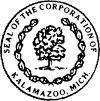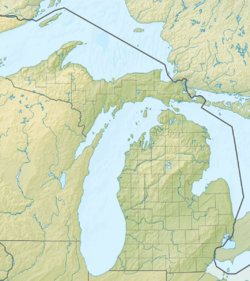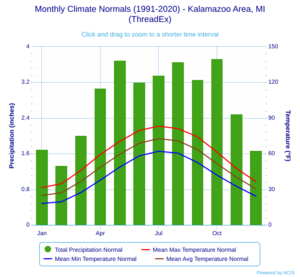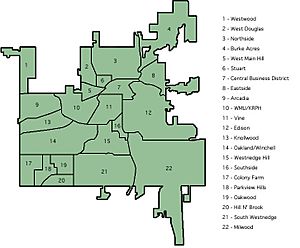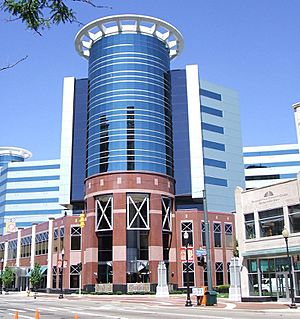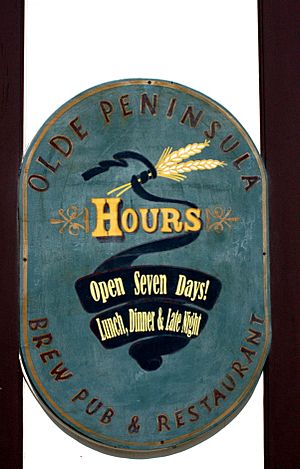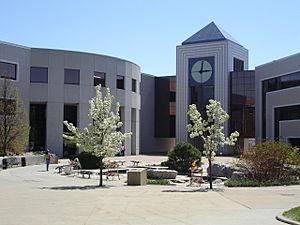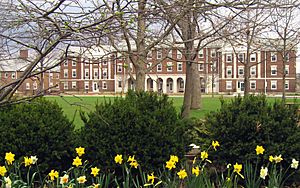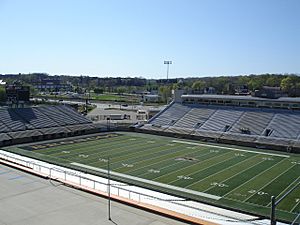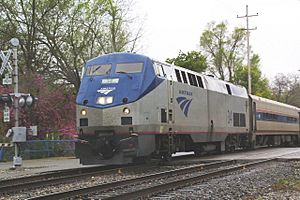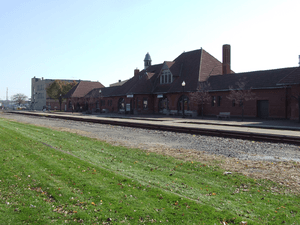Kalamazoo, Michigan facts for kids
Quick facts for kids
Kalamazoo, Michigan
|
|||||
|---|---|---|---|---|---|
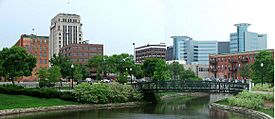
Downtown skyline of Kalamazoo
|
|||||
|
|||||
| Nicknames:
The Mall City, Kzoo, The Zoo
|
|||||
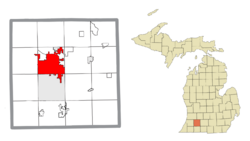
Location within Kalamazoo County
|
|||||
| Country | United States | ||||
| State | Michigan | ||||
| County | Kalamazoo | ||||
| Settled | 1829 | ||||
| Incorporated | 1843 (village) 1884 (city) |
||||
| Government | |||||
| • Type | City commission | ||||
| Area | |||||
| • City | 25.14 sq mi (65.12 km2) | ||||
| • Land | 24.69 sq mi (63.96 km2) | ||||
| • Water | 0.45 sq mi (1.16 km2) | ||||
| Elevation | 784 ft (239 m) | ||||
| Population
(2020)
|
|||||
| • City | 73,598 | ||||
| • Density | 2,980.69/sq mi (1,150.85/km2) | ||||
| • Urban | 204,562 (US: 189th) | ||||
| • Metro | 261,108 (US: 189th) | ||||
| • CSA | 500,670 (US: 89th) | ||||
| Demonym(s) | Kalamazooian | ||||
| Time zone | UTC-5 (Eastern (EST)) | ||||
| • Summer (DST) | UTC-4 (EDT) | ||||
| ZIP Code(s) |
49001, 49003–49009, 49019, 49048
|
||||
| Area code(s) | 269 | ||||
| FIPS code | 26-42160 | ||||
| GNIS feature ID | 0629439 | ||||
Kalamazoo (/ˌkæləməˈzuː/ KAL-ə-MƏ-zoo) is a city in Michigan, United States. It is the main city of the Kalamazoo–Portage area. In 2020, about 73,598 people lived in Kalamazoo. The wider metropolitan area had a population of 261,670.
One special feature of Kalamazoo is the Kalamazoo Mall. This was the first outdoor shopping mall in the United States. It was created in 1959 by closing part of Burdick Street to cars. Kalamazoo is also home to several colleges. These include Western Michigan University, Kalamazoo College, and Kalamazoo Valley Community College.
Contents
What Does Kalamazoo Mean?
The name "Kalamazoo" comes from a Potawatomi word. It was first written down in a British report in 1772. The Kalamazoo River flows through the city. French-Canadian traders knew this river as La rivière Kikanamaso.
There are a few ideas about what "Kikanamaso" means. One story says "Ki-ka-ma-sung" means "boiling water." This might refer to a footrace where people ran to the river and back before a pot boiled. Another idea is that it means "otter tail" or "stones like otters." Some also think it means "the mirage or reflecting river." The name "boiling water" could also describe fog on the river seen from nearby hills.
The name Kalamazoo sounds unique to English speakers. It has become a fun way to talk about faraway places. People sometimes say "from Timbuktu to Kalamazoo." You can even find T-shirts in Kalamazoo that say, "Yes, there really is a Kalamazoo."
Kalamazoo's History
The area where Kalamazoo now stands was once home to Native American groups. The Hopewell tradition people lived here before the first millennium. You can still see a small mound in Bronson Park from their time. Later, the Potawatomi culture lived in the area when Europeans arrived.
The first Europeans to live here were fur traders in the late 1700s and early 1800s. They set up trading posts. During the War of 1812, the British had a smithy and a prison camp here.
In 1829, Titus Bronson from Connecticut built the first cabin in the city. He planned the town in 1831 and called it Bronson. The village was renamed Kalamazoo in 1836. This happened partly because Bronson was known for being a bit difficult. Today, a hospital and a park are named after him. Kalamazoo became a village in 1838 and a city in 1883.
Many early settlers were farmers from New England and New York. They came to the area because of the good farmland. Their children often became business people and started factories in Kalamazoo.
On August 27, 1856, Abraham Lincoln gave a speech in Kalamazoo. He was campaigning for the first Republican presidential candidate. This was the only time Lincoln ever visited Michigan. A statue of Lincoln will be placed in Bronson Park to remember this event.
In the 1940s, Kalamazoo was the first city to install curb cuts. These are sloped parts of sidewalks that make it easier for wheelchairs and strollers to cross streets.
In 1959, the city created the Kalamazoo Mall. This was the first outdoor pedestrian shopping mall in the United States. It was designed by Victor Gruen. Two of the mall's four blocks were reopened to cars in 1999.
On May 13, 1980, a strong tornado hit downtown Kalamazoo. It caused a lot of damage and sadly, five people lost their lives. On February 20, 2016, a sad event occurred where several people lost their lives.
Kalamazoo's Economic Past
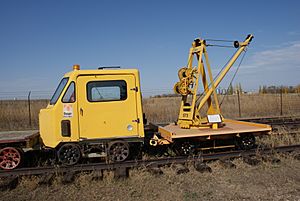
In the past, Kalamazoo was known for making many things. These included windmills, mandolins, buggies, automobiles, and paper. The area was also famous for growing celery. Today, the surrounding areas still grow farm crops like corn and soybeans. Many local trails are named after the celery industry.
Kalamazoo was the first home of the Gibson Guitar Corporation. This company was started by Orville Gibson in 1902. Gibson later moved its operations to other states. However, some workers stayed in Kalamazoo and started a new company called Heritage Guitars.
Kalamazoo was once called the "Paper City." This was because of the many paper mills in the area. The Allied Paper Corporation employed 1,300 people in the 1960s. Over time, as forests were used up, many paper mills closed.
In the early 1900s, the Brass Era car company Barley was also in Kalamazoo. The city was also the headquarters for Checker Motors Company. This company made the famous Checker Cab and parts for other car makers. Checker Motors closed in 2009.
Geography and Climate
Most of Kalamazoo is on the southwest side of the Kalamazoo River. Some smaller streams, like Arcadia Creek, flow through the city. The eastern part of Kalamazoo is in a flat valley. The western parts rise into low hills. There are also several small lakes nearby. Kalamazoo is about 50 miles (80 km) south of Grand Rapids. It is 75 miles (121 km) southwest of Lansing.
The city has a total area of about 25.11 square miles (65.03 km2). About 0.43 square miles (1.11 km2) of this is water. The suburban areas of Kalamazoo are mostly to the south in Portage and to the west in Oshtemo and Texas townships.
Kalamazoo gets some of its water from the Al Sabo Preserve. This is a natural area southwest of the city. Another natural area, Kleinstuck Marsh, is popular for hiking and birdwatching.
Weather in Kalamazoo
Kalamazoo has a humid continental climate. This means it has warm summers and cold winters. Summers can be hot and humid, lasting from May to September. Tornadoes are rare but can happen. For example, a major tornado hit downtown Kalamazoo in 1980.
In winter, temperatures can sometimes drop below 0°F (-18°C). Kalamazoo is known for heavy snowstorms, even into early April. Lake-effect snow is common in winter. This happens when cold air moves over the warmer Great Lakes, picking up moisture and dropping it as snow.
| Climate data for Kalamazoo Battle Ck Intl Ap, MI, 1991–2020 normals, extremes 1887-present | |||||||||||||
|---|---|---|---|---|---|---|---|---|---|---|---|---|---|
| Month | Jan | Feb | Mar | Apr | May | Jun | Jul | Aug | Sep | Oct | Nov | Dec | Year |
| Record high °F (°C) | 67 (19) |
71 (22) |
85 (29) |
89 (32) |
96 (36) |
102 (39) |
109 (43) |
104 (40) |
100 (38) |
90 (32) |
81 (27) |
69 (21) |
109 (43) |
| Mean maximum °F (°C) | 51.9 (11.1) |
54.6 (12.6) |
69.9 (21.1) |
80.0 (26.7) |
86.5 (30.3) |
92.1 (33.4) |
93.0 (33.9) |
91.8 (33.2) |
89.6 (32.0) |
80.4 (26.9) |
66.0 (18.9) |
55.5 (13.1) |
94.9 (34.9) |
| Mean daily maximum °F (°C) | 31.5 (−0.3) |
34.7 (1.5) |
45.9 (7.7) |
59.3 (15.2) |
70.3 (21.3) |
79.5 (26.4) |
83.1 (28.4) |
81.1 (27.3) |
74.1 (23.4) |
61.3 (16.3) |
47.6 (8.7) |
36.5 (2.5) |
58.7 (14.8) |
| Daily mean °F (°C) | 24.8 (−4.0) |
27.1 (−2.7) |
36.6 (2.6) |
48.5 (9.2) |
59.5 (15.3) |
68.8 (20.4) |
72.6 (22.6) |
70.8 (21.6) |
63.3 (17.4) |
51.6 (10.9) |
40.1 (4.5) |
30.4 (−0.9) |
49.5 (9.7) |
| Mean daily minimum °F (°C) | 18.1 (−7.7) |
19.5 (−6.9) |
27.3 (−2.6) |
37.7 (3.2) |
48.7 (9.3) |
58.1 (14.5) |
62.0 (16.7) |
60.4 (15.8) |
52.5 (11.4) |
41.9 (5.5) |
32.5 (0.3) |
24.2 (−4.3) |
40.2 (4.6) |
| Mean minimum °F (°C) | −2.5 (−19.2) |
1.5 (−16.9) |
8.4 (−13.1) |
23.7 (−4.6) |
33.6 (0.9) |
43.8 (6.6) |
50.7 (10.4) |
48.8 (9.3) |
39.1 (3.9) |
29.0 (−1.7) |
19.0 (−7.2) |
6.8 (−14.0) |
−6.4 (−21.3) |
| Record low °F (°C) | −20 (−29) |
−22 (−30) |
−12 (−24) |
6 (−14) |
24 (−4) |
34 (1) |
39 (4) |
36 (2) |
29 (−2) |
17 (−8) |
−7 (−22) |
−14 (−26) |
−22 (−30) |
| Average precipitation inches (mm) | 1.70 (43) |
1.34 (34) |
2.01 (51) |
3.07 (78) |
3.70 (94) |
3.20 (81) |
3.36 (85) |
3.66 (93) |
3.27 (83) |
3.74 (95) |
2.50 (64) |
1.68 (43) |
33.23 (844) |
| Average precipitation days (≥ 0.01 in) | 11.5 | 9.2 | 10.7 | 12.6 | 13.3 | 11.7 | 10.4 | 12.0 | 12.0 | 13.2 | 11.0 | 12.5 | 140.1 |
| Source: NOAA | |||||||||||||
People of Kalamazoo
| Historical population | |||
|---|---|---|---|
| Census | Pop. | %± | |
| 1840 | 1,290 | — | |
| 1850 | 2,507 | 94.3% | |
| 1860 | 6,070 | 142.1% | |
| 1870 | 9,181 | 51.3% | |
| 1880 | 11,937 | 30.0% | |
| 1890 | 17,853 | 49.6% | |
| 1900 | 24,404 | 36.7% | |
| 1910 | 39,437 | 61.6% | |
| 1920 | 48,487 | 22.9% | |
| 1930 | 54,786 | 13.0% | |
| 1940 | 54,097 | −1.3% | |
| 1950 | 57,704 | 6.7% | |
| 1960 | 82,189 | 42.4% | |
| 1970 | 85,555 | 4.1% | |
| 1980 | 79,722 | −6.8% | |
| 1990 | 80,277 | 0.7% | |
| 2000 | 76,145 | −5.1% | |
| 2010 | 74,262 | −2.5% | |
| 2020 | 73,598 | −0.9% | |
| U.S. Decennial Census 2018 Estimate |
|||
In 2010, there were 74,262 people living in Kalamazoo. The city had 29,141 households. About 25.8% of households had children under 18. The average household had 2.29 people.
The population was made up of different groups. About 68.1% were White, and 22.2% were African American. About 6.4% of the population was Hispanic or Latino. The average age in the city was 26.2 years old.
Kalamazoo Neighborhoods
Kalamazoo is divided into 22 neighborhoods. Many of these have their own neighborhood associations. The city government works with these groups. They help improve communities and support economic growth.
Kalamazoo's Economy
Kalamazoo has been recognized for its efforts to improve its economy. In 2007, Fast Company magazine named it one of the 'Most Innovative Companies'. In 2012, Kiplinger's Personal Finance called it one of the 'Ten Best Cities for Cheapskates'. In 2014, NerdWallet.com listed it as a 'Top 10 Best Cities for Work-Life Balance'.
Local Breweries
Kalamazoo has many local breweries and brewpubs. They make different kinds of beer.
One of the most famous is Bell's Brewery. Larry Bell started it in 1985. Bell's beer is now sold in 40 U.S. states. Other local breweries include One Well Brewing. Smaller places like Olde Peninsula Brewpub also make their own beers. The area is known for its craft beer scene. Events like Kalamazoo Beer Week celebrate this industry.
Flavoring Companies
The A.M. Todd Company is based in Kalamazoo. It is a leading producer of peppermint oil and other flavorings. Its founder, Albert M. Todd, was once a U.S. Representative.
Kalamazoo is also home to Kalsec, another flavoring company. It was founded by Paul H. Todd Jr., Albert Todd's grandson. Kalsec makes flavorings from plants.
Manufacturing in Kalamazoo
Stryker Corporation is a Kalamazoo-based company. It makes medical equipment. Kalamazoo Outdoor Gourmet designs and builds outdoor kitchen equipment.
Fabri-Kal makes food service containers from plastic and plant-based materials. They have their main office in Kalamazoo. They also have a large, environmentally friendly manufacturing facility.
Parker Hannifin Aerospace has a division in Kalamazoo. They design and make parts for planes. These include hydraulic pumps and actuators for military and commercial aircraft.
Life Sciences and Health
The Upjohn Company was a pharmaceutical company started in Kalamazoo in 1886. Its facilities are now part of Pfizer Corporation. Many of the original Upjohn buildings are still used. Some are now part of the Western Michigan University Homer Stryker M.D. School of Medicine. Others are used by Zoetis and Bronson Methodist Hospital.
The Western Michigan University Homer Stryker M.D. School of Medicine (WMed) opened in 2014. It is a partnership between Western Michigan University and local hospitals. It helps train new doctors.
Zoetis is the world's largest maker of medicine and vaccinations for pets and livestock. Its global research and development office is in downtown Kalamazoo.
Kalamazoo is also home to the Stryker Corporation. This company makes surgical and medical devices. The city has several hospitals, including Bronson Methodist Hospital and Ascension Borgess Hospital.
Other Businesses
PNC Bank has a large presence in Kalamazoo. It took over First of America Bank, which used to have its main office here.
Henderson Castle is a historic house from 1895. It is now a bed and breakfast, restaurant, and spa. It overlooks the city from West Main Hill.
Education in Kalamazoo
Kalamazoo is a center for education. It is home to Western Michigan University. This large public university has four campuses in Kalamazoo. In 2005, it was ranked as the second-best wireless campus in the U.S.
Each May, Western Michigan University hosts a big event called the International Congress on Medieval Studies. About 3,000 professors and students come from all over the world. They discuss topics related to the Middle Ages.
Kalamazoo College is a private liberal arts college. It was founded in 1833 and is located near Western Michigan University.
Kalamazoo also has Kalamazoo Valley Community College. It is also home to the Kalamazoo Area Mathematics and Science Center (KAMSC).
K-12 Schools
Most public schools in Kalamazoo are part of Kalamazoo Public Schools. The city has a special program called the Kalamazoo Promise. This program gives every graduate of Kalamazoo Public Schools a scholarship. It can cover up to 100% of tuition for four years at any public university or community college in Michigan. This program started with the class of 2006.
Some small parts of Kalamazoo are in other school districts. These include Parchment School District and Portage Public Schools.
Culture and Fun
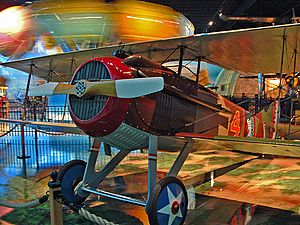
Kalamazoo has an Arts Council. On the first Friday of each month, they organize 'Art Hop'. This is a free event where downtown businesses show art by local artists. People can walk around, enjoy art, listen to music, and meet artists.
On New Year's Eve, downtown Kalamazoo hosts New Year's Fest. This celebration is in Bronson Park and nearby places. It offers music, magic, comedy, and fireworks for all ages. It started in 1985 and has become very popular.
Music groups and performers play at the downtown State Theatre and Western Michigan University's Miller Auditorium.
There is no longer a zoo in Kalamazoo. The Milham Park Zoo closed in 1974. Next to Milham Park is the Milham Park Golf Course. It is an 18-hole course. In winter, people can go sledding or cross-country skiing there for free.
In 2002, the Kalamazoo Public Library was named "Library of the Year." The library has a main location and four branches. It also has 'The Hub', a digital lab where people can digitize photos and videos.
Kalamazoo has several theaters and performing groups. These include the Kalamazoo Civic Theatre and The New Vic Theatre. Plays and musicals are also performed at Kalamazoo College and Western Michigan University.
Animation Festival
The Kalamazoo Animation Festival International (KAFI) is a project of Kalamazoo Valley Community College. It helps animation artists and promotes the animation industry. It also provides fun for the community. The festival happens every two years. It includes film competitions and workshops.
Museums to Explore
The main art museum in the city is the Kalamazoo Institute of Arts. It has over 3,600 works, focusing on 20th-century American art. The museum also hosts temporary art shows.
The Kalamazoo Valley Museum is run by Kalamazoo Valley Community College. It has "hands-on" exhibits that are great for children. It also has a planetarium and a Challenger Learning Center.
Northeast of town is the Gilmore Car Museum. It has many cars, including some used in Walt Disney movies. The Kalamazoo Air Zoo, south of town, has dozens of aircraft on display. You can see everything from old biplanes to modern jets.
Music Scene
The Gibson Guitar Corporation was founded in Kalamazoo in 1902. This encouraged local musicians to play many styles of music. The Kalamazoo Symphony Orchestra started in 1921. The city also hosts the Irving S. Gilmore International Keyboard Festival.
Kalamazoo has a lively local music scene. It has produced bands like The Verve Pipe. The city also hosts the Kalamashoegazer music festival.
Sports in Kalamazoo
Kalamazoo is home to several sports teams:
- The Kalamazoo Growlers are a summer college baseball team. They play at Homer Stryker Field.
- The Kalamazoo Wings (K-Wings) are a minor league hockey team. They play at Wings Event Center.
- The Kalamazoo FC is a soccer team that started in 2016.
The Western Michigan University Broncos compete in NCAA Division I. They play football at Waldo Stadium and hockey at Lawson Arena. Their basketball and volleyball teams play at University Arena.
Hyames Field hosted the first two College World Series in 1947 and 1948. Future U.S. President George H. W. Bush played baseball there.
Kalamazoo is the hometown of famous athletes. These include former New York Yankees shortstop Derek Jeter and former NFL wide receiver Greg Jennings.
The United States Tennis Association Boys 18 and 16 National Tennis Championships are held every summer. This event has featured future professional players like Jimmy Connors and Andre Agassi.
The Kalamazoo Rugby Football Club started in 1988. The Wings Event Center also hosts roller derby and curling championships. The annual Kalamazoo Marathon is a popular running event.
Media and News
Newspapers
Kalamazoo has one daily newspaper, the Kalamazoo Gazette. It prints seven days a week.
Television
WWMT is a local TV station that serves West Michigan. It is based in Kalamazoo. The station was first owned by John Fetzer, who also owned the Detroit Tigers. Fetzer also started Kalamazoo's first cable television system.
Public Media Network in downtown Kalamazoo offers public access TV channels. Kalamazoo is part of the West Michigan television market. This includes Grand Rapids and Battle Creek.
Radio Stations
WIDR is a college radio station at Western Michigan University. It plays unique and underground music. WMUK is also on Western Michigan University's campus. It plays local music and programs from NPR.
WKDS is a high school student-run radio station. It broadcasts from Loy Norrix High School. Students from the area operate the station.
Many other FM and AM radio stations can be heard in Kalamazoo. These include stations playing Christian music, classic rock, country, and news/talk.
Getting Around Kalamazoo
Highways
Kalamazoo is served by major highways. These include I-94, US 131, M-96, and M-343. The city was on the old Territorial Road from the 1800s.
Train Service
Kalamazoo has train service provided by Amtrak. The station is downtown and is combined with a bus terminal. Kalamazoo is a hub for Amtrak's high-speed line. Trains can go up to 110 mph (177 km/h) between Porter, Indiana, and Albion, Michigan.
Freight train service is also available. It is provided by the Grand Elk Railroad.
Bus Service
Bus service to and through the city is provided by Greyhound and Indian Trails. Public bus services within the city are provided by Metro.
Air Travel
The Kalamazoo/Battle Creek International Airport (AZO) is on the southern end of the city. It offers flights to major hubs and vacation spots. A new terminal was finished in 2011.
Trails for Fun
The Kal-Haven Trail is popular for biking, running, walking, and snowmobiling. It is 34 miles (55 km) long. It runs from South Haven to just west of Kalamazoo. This trail was built on an old railroad line.
The Kalamazoo River Valley Trail extends from the Kal-Haven Trail into downtown Kalamazoo. This trail is managed by Kalamazoo County.
Sister Cities
Kalamazoo has three sister cities. These are cities in other countries that Kalamazoo has a special relationship with.
 Kingston, Jamaica
Kingston, Jamaica Numazu, Shizuoka, Japan
Numazu, Shizuoka, Japan Pushkin, St. Petersburg, Russia
Pushkin, St. Petersburg, Russia
See also
 In Spanish: Kalamazoo (Míchigan) para niños
In Spanish: Kalamazoo (Míchigan) para niños



